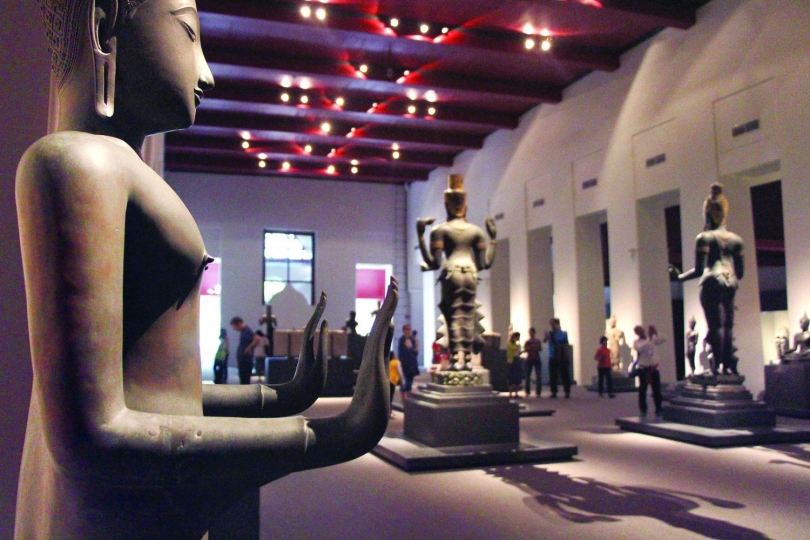New light on a gloried past

History feels closer than ever as the first of the venerable exhibition halls at the National Museum opens wide
THE NATIONAL Museum Bangkok’s Siwamokkhaphiman building has reopened after a year and a half’s renovation with a remarkable exhibition on Thai history.
Artefacts from old Sukhothai and Ayutthaya as well as the Thonburi and early Rattanakosin eras are on view in an entirely revamped interior, shorn of walls and other obstacles to exploration. The open-plan design shows off the beautiful high ceilings. The sophisticated new lighting illuminates the Buddhist painting and sculptures wonderfully.
You can even take photographs as long as you don’t use a flash.
The government’s Fine Arts Department is doing a great job bringing back the glory of all the buildings at the former Wang Na Palace, which dates to 1782, the same period the Grand Palace was erected. This one was the residence of five viceroys prior to the reign of King Rama V. Two other buildings in the compound are currently being restored with an eye to completing the project in six years.
“The Siwamokkhaphiman is the first building to be renovated,” says museum director Phnombootra Chandrajoti. “It was the throne hall of the viceroys. All the partitions that separated the exhibition space were removed to reveal the beautiful architecture of the hall.”
Bt25 million was spent renovating the roof, walls, ceiling and gables and installing new lighting that makes the facility more inviting, a place where you want to linger. There are 111 Buddhist sculptures on display spanning 10,000 years, ranging from pre-history through the Dvaravati, Srivijaya, Lopburi, Lanna, Sukhothai and Ayutthaya periods to the early Rattanakosin.
Here you can see – finally moved indoors from the museum entrance – the King Ramkhamhaeng Inscription, one of the most important artefacts in our history. Dated to 1292, it records in stone the invention of the Thai language.
What you don’t find anymore are the dimly lit exhibition rooms where visitors used to have to “feel” their way among displays on Holocene culture and the establishment of the royal Chakri Dynasty.
“The old rooms relied mainly on natural light from the windows, but the new lighting enhances the visual energy of each piece and leads visitors through each era,” curator Yutthanawarakorn Saengarm points out. “Thanks to the high ceiling and the huge space, we’ve been able to place large sculptures together at the centre of the hall. The smaller pieces are in glass cabinets set out in a ‘U’ shape around the hall.”
Visits are best begun watching a brief video about the architectural styles typical of each era.
One of the more intriguing items from prehistory is a bronze kettledrum estimated to be between 2,400 and 2,700 years old, dating to a time when metal-casting was first discovered. The drum was cast in parts that were then welded together and decorated with a 10-pointed star, a bird in flight and geometric patterns.
“The drum is believed to have been used in rain ceremonies,” says Yutthanawarakorn. “Such use was part of the culture of Southeast Asia and can still be seen in China, Vietnam and Myanmar. In Thailand today you only see the traditional kettledrum used in the overture for processions of His Majesty the King.”
He points out a 1.67-metre-tall Buddha head in gilded bronze from Ayutthaya, possibly forged half a millennium ago. It was unearthed in the main vihara of Wat Phra Si Sanphet in Siam’s former capital. Flanking it is a pair of 14th-century renderings of the deities Vishnu and Ishvara that represent “the golden age of Thai arts” during the Sukhothai Period.
Of the huge, 800-tonne head of the Buddha, Yutthanawarakorn surmises that the intact statue – the rest of the body was never found – must have been more than 10 metres in height.
“It was made in the Middle Ayutthaya Period, by which time the artisans had adopted the older Sukhothai characteristics. The construction of large Buddha images became very popular, using gilded or plated bronze, with the classical oval face, curving, thick eyebrows, long nose and lips tapering at the tips.”
The 13th-century sandstone sculpture known as the Radiating Bodhisattva Avalokitesvara bears characteristics of ancient Khmer art in the Bayon style. This piece was one of five excavated in Thailand with beautiful features and virtually complete, through the extremities of its eight arms have broken off and been lost. The figure is standing, the hair drawn into a bun that’s engraved at the front with a tiny image of the meditating Buddha. Around the torso are more Buddha images postured to signify enlightenment.
Another Bodhisattva Avaloki- |tesvara, with even more elaborate features, is a late-ninth-century bronze bust found in southern Surat Thani province. It’s a magnificent example of the sculpture of Srivijava, a kingdom of federated states in modern-day Sumatra, Java, Malaysia and Thailand. Srivijayan sculpture and architecture found in Thailand indicate allegiance to Mahayana and Vajrayana Buddhism, in which the Ava- |lokitesvara is regarded as the highest manifestation of the bodhisattva.
For now, there are audio guides in Thai and English available to explain several of the more significant exhibits and guided tours must be booked in advance. Plans are in the works, though, to offer more languages, as well as a “virtual tour”, QR codes for smartphones to access further information, and 3D visualisations for some pieces using “augmented reality”.
FRESH FACES
The National Museum Bangkok is on Na Phrathat Road next to Thammasat University.
Admission is Bt30 (Bt200 for foreigners).
It’s open Wednesday through Sunday from 9am to 4pm.
Find out more at (02) 224 1370 and the “National Museum Bangkok” page on Facebook.
RELATED





